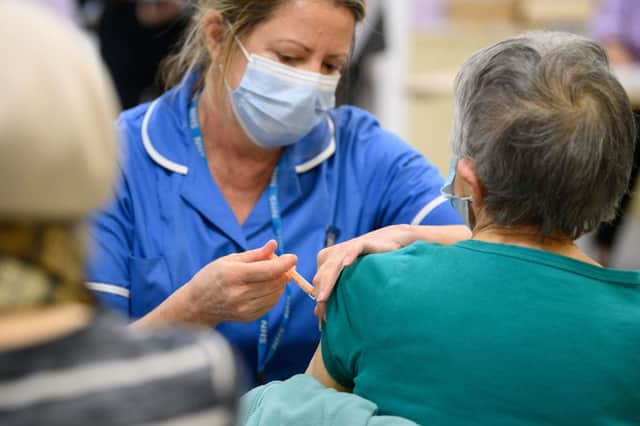New data shows how many people over 80 have received a first Covid dose in your area


The number of administered first doses of coronavirus vaccines in the UK has hit five million, as the country continues the biggest vaccination programme in its history.
Everyone over the age of 70 and those that are extremely clinically vulnerable are currently entitled to receive a coronavirus vaccine, as well as the over-80s, care home residents, NHS staff and social care staff.
Advertisement
Hide AdAdvertisement
Hide AdNew figures show the number and proportion of people aged 80 and over who have received a first dose of a Covid-19 vaccine in England. The data has revealed that, depending on the area you live in, there’s some variation.
The provisional figures are broken down into sub-regional areas of England, officially known as sustainability and transformational partnerships (STPs).
Gloucestershire takes top spot
There are 42 STPs in England. Gloucestershire STP has the highest proportion of people 80 years and over who have received their first dose.
Northamptonshire was in second place with 78 per cent of over-80s there receiving the jab, followed by Hereford and Worcestershire in third place, with 76 per cent.
Advertisement
Hide AdAdvertisement
Hide AdThe data is based on provisional data from NHS England for vaccinations up to 17 January 2021, combined with population estimates from the Office for National Statistics (ONS).
Loading....
How many people aged over 80 have been vaccinated where you live?
- Gloucestershire - 31,903 (85.3%)
- Northamptonshire - 25,587 (78.2%)
- Herefordshire and Worcestershire - 37,609 (76.2%)
- Healthier Lancashire and South Cumbria - 70,027 (75.7%)
- Cumbria and North East - 114,117 (70.8%)
- Bristol, North Somerset and South Gloucestershire - 33,429 (70.6%)
- Frimley Health and Care ICS - 23,985 (70.3%)
- Hampshire and the Isle of Wight - 74,107 (69.7%)
- Humber, Coast and Vale - 68,506 (67.8%)
- Hertfordshire and West Essex - 50,815 (66.3%)
- Birmingham and Solihull - 34,898 (66.3%)
- West Yorkshire and Harrogate Health and Care Partnership - 68,120 (63.6%)
- The Black Country and West Birmingham - 40,774 (63.4%)
- South Yorkshire and Bassetlaw - 47,328 (63.0%)
- Coventry and Warwickshire - 29,382 (62.2%)
- Buckinghamshire, Oxfordshire and Berkshire West - 54,760 (62.0%)
- Staffordshire and Stoke on Trent - 37,001 (60.8%)
- Mid and South Essex - 38,503 (60.5%)
- Bath and North East Somerset, Swindon and Wiltshire - 30,040 (59.7%)
- Greater Manchester Health and Social Care Partnership - 70,505 (59.6%)
- Dorset - 34,242 (59.5%)
- Cheshire and Merseyside - 80,366 (59.4%)
- Surrey Heartlands Health and Care Partnership - 34,528 (56.9%)
- Joined Up Care Derbyshire - 31,630 (56.9%)
- Somerset - 21,680 (56.6%)
- South West London Health and Care Partnership - 31,295 (56.6%)
- Bedfordshire, Luton and Milton Keynes - 22,292 (56.1%)
- North London Partners in Health and Care - 28,226 (55.1%)
- Cornwall and the Isles of Scilly Health and Social Care Partnership - 19,535 (53.4%)
- Leicester, Leicestershire and Rutland - 27,826 (52.7%)
- Lincolnshire - 24,253 (52.2%)
- Norfolk and Waveney Health and Care Partnership - 36,809 (51.6%)
- Kent and Medway - 49,208 (50.2%)
- Devon - 39,880 (50.1%)
- Shropshire and Telford and Wrekin - 14,031 (49.0%)
- East London Health and Care Partnership - 27,886 (48.5%)
- Sussex and East Surrey Health and Care Partnership - 52,462 (46.9%)
- Cambridgeshire and Peterborough - 20,474 (45.7%)
- Our Healthier South East London - 27,708 (45.7%)
- North West London Health and Care Partnership - 35,171 (45.7%)
- Nottingham and Nottinghamshire Health and Care - 21,510 (43.2%)
- Suffolk and North East Essex - 22,265 (36.0%)